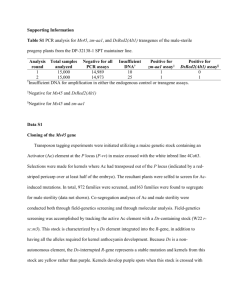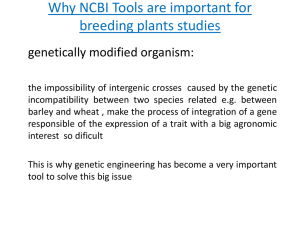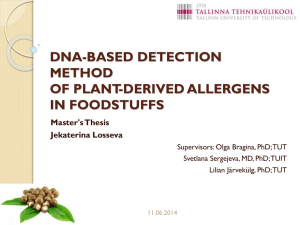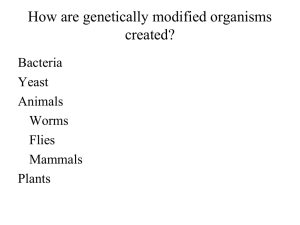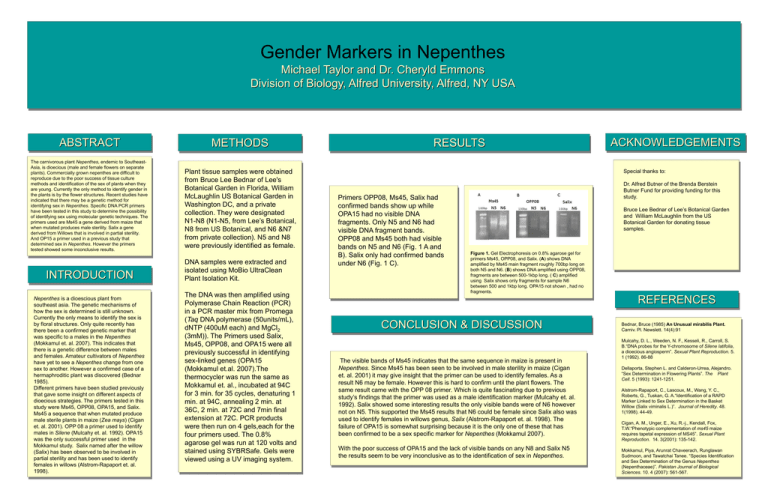
Gender Markers in Nepenthes
Michael Taylor and Dr. Cheryld Emmons
Division of Biology, Alfred University, Alfred, NY USA
ABSTRACT
The carnivorous plant Nepenthes, endemic to SoutheastAsia, is dioecious (male and female flowers on separate
plants). Commercially grown nepenthes are difficult to
reproduce due to the poor success of tissue culture
methods and identification of the sex of plants when they
are young. Currently the only method to identify gender in
the plants is by the flower structures. Recent studies have
indicated that there may be a genetic method for
identifying sex in Nepenthes. Specific DNA PCR primers
have been tested in this study to determine the possibility
of identifying sex using molecular genetic techniques. The
primers used are Ms45 a gene derived from maize that
when mutated produces male sterility. Salix a gene
derived from Willows that is involved in partial sterility.
And OP15 a primer used in a previous study that
determined sex in Nepenthes. However the primers
tested showed some inconclusive results.
INTRODUCTION
Nepenthes is a dioescious plant from
southeast asia. The genetic mechanisms of
how the sex is determined is still unknown.
Currently the only means to identify the sex is
by floral structures. Only quite recently has
there been a confirmed genetic marker that
was specific to a males in the Nepenthes
(Mokkamul et. al. 2007). This indicates that
there is a genetic difference between males
and females. Amateur cultivators of Nepenthes
have yet to see a Nepenthes change from one
sex to another. However a confirmed case of a
hermaphroditic plant was discovered (Bednar
1985).
Different primers have been studied previously
that gave some insight on different aspects of
dioecious strategies. The primers tested in this
study were Ms45, OPP08, OPA15, and Salix.
Ms45 a sequence that when mutated produce
male sterile plants in maize (Zea mays) (Cigan
et. al. 2001). OPP 08 a primer used to identify
males in Silene (Mulcahy et. al. 1992). OPA15
was the only successful primer used in the
Mokkamul study. Salix named after the willow
(Salix) has been observed to be involved in
partial sterility and has been used to identify
females in willows (Alstrom-Rapaport et. al.
1998).
METHODS
Plant tissue samples were obtained
from Bruce Lee Bednar of Lee's
Botanical Garden in Florida, William
McLaughlin US Botanical Garden in
Washington DC, and a private
collection. They were designated
N1-N8 (N1-N5, from Lee’s Botanical,
N8 from US Botanical, and N6 &N7
from private collection). N5 and N8
were previously identified as female.
DNA samples were extracted and
isolated using MoBio UltraClean
Plant Isolation Kit.
The DNA was then amplified using
Polymerase Chain Reaction (PCR)
in a PCR master mix from Promega
(Taq DNA polymerase (50units/mL),
dNTP (400uM each) and MgCl2
(3mM)). The Primers used Salix,
Ms45, OPP08, and OPA15 were all
previously successful in identifying
sex-linked genes (OPA15
(Mokkamul et.al. 2007).The
thermocycler was run the same as
Mokkamul et. al., incubated at 94C
for 3 min. for 35 cycles, denaturing 1
min. at 94C, annealing 2 min. at
36C, 2 min. at 72C and 7min final
extension at 72C. PCR products
were then run on 4 gels,each for the
four primers used. The 0.8%
agarose gel was run at 120 volts and
stained using SYBRSafe. Gels were
viewed using a UV imaging system.
RESULTS
ACKNOWLEDGEMENTS
Special thanks to:
Primers OPP08, Ms45, Salix had
confirmed bands show up while
OPA15 had no visible DNA
fragments. Only N5 and N6 had
visible DNA fragment bands.
OPP08 and Ms45 both had visible
bands on N5 and N6 (Fig. 1 A and
B). Salix only had confirmed bands
under N6 (Fig. 1 C).
Dr. Alfred Butner of the Brenda Berstein
Butner Fund for providing funding for this
study.
Bruce Lee Bednar of Lee’s Botanical Garden
and William McLaughlin from the US
Botanical Garden for donating tissue
samples.
Figure 1. Gel Electrophoresis on 0.8% agarose gel for
primers Ms45, OPP08, and Salix. (A) shows DNA
amplified by Ms45 main fragment roughly 700bp long on
both N5 and N6. (B) shows DNA amplified using OPP08,
fragments are between 500-1kbp long. ( C) amplified
using Salix shows only fragments for sample N6
between 500 and 1kbp long. OPA15 not shown , had no
fragments.
REFERENCES
CONCLUSION & DISCUSSION
The visible bands of Ms45 indicates that the same sequence in maize is present in
Nepenthes. Since Ms45 has been seen to be involved in male sterility in maize (Cigan
et. al. 2001) it may give insight that the primer can be used to identify females. As a
result N6 may be female. However this is hard to confirm until the plant flowers. The
same result came with the OPP 08 primer. Which is quite fascinating due to previous
study’s findings that the primer was used as a male identification marker (Mulcahy et. al.
1992). Salix showed some interesting results the only visible bands were of N6 however
not on N5. This supported the Ms45 results that N6 could be female since Salix also was
used to identify females in willows genus, Salix (Alstrom-Rapaport et. al. 1998). The
failure of OPA15 is somewhat surprising because it is the only one of these that has
been confirmed to be a sex specific marker for Nepenthes (Mokkamul 2007).
With the poor success of OPA15 and the lack of visible bands on any N8 and Salix N5
the results seem to be very inconclusive as to the identification of sex in Nepenthes.
Bednar, Bruce (1985) An Unusual mirabilis Plant.
Carniv. Pl. Newslett. 14(4):91
Mulcahy, D. L., Weeden, N. F., Kesseli, R., Carroll, S.
B.“DNA probes for the Y-chromosome of Silene latifolia,
a dioecious angiosperm”. Sexual Plant Reproduction. 5.
1 (1992). 86-88
Dellaporta, Stephen L. and Calderon-Urrea, Alejandro.
“Sex Determination in Flowering Plants”. The Plant
Cell. 5 (1993): 1241-1251.
Alstrom-Rapaport, C., Lascoux, M., Wang, Y. C.,
Roberts, G., Tuskan, G. A.“Identification of a RAPD
Marker Linked to Sex Determination in the Basket
Willow (Salix viminalis L.)”. Journal of Heredity. 48.
1(1998). 44-49.
Cigan, A. M., Unger, E., Xu, R.-j., Kendall, Fox,
T.W.“Phenotypic complementation of ms45 maize
requires tapetal expression of MS45”. Sexual Plant
Reproduction. 14. 3(2001): 135-142.
Mokkamul, Piya, Arunrat Chaveerach, Runglawan
Sudmoon, and Tawatchai Tanee. “Species Identification
and Sex Determination of the Genus Nepenthes
(Nepenthaceae)”. Pakistan Journal of Biological
Sciences. 10. 4 (2007): 561-567.


